Special Beijing Welcomes You Part 1

|
• New Linden Hotel • Duke of Leinster Hotel • Russell Hotel • Waverley House Hotel |
Please enjoy the first of this two part series by Tom Tweedel. We're working behind the scenes to bring our new website online and we plan to go live with the new site as a special on May 22nd. During this opening special we'll introduce the new site and show you all the new areas and how to use them. From forums to user galleries to comments on each piece, we hope to bring the Thailand expat community a quality photo site with all the important features. I hope you're looking forward to it as much as we are.
Tom Tweedel is a good friend with significant experience in China and has self-published severalinteresting volumes of his travels in China complete with many great images and informative narrative. Last year he visited Thailand for the first time and I had a great time showing him around the area. Somehow he found time to put together a like 340 page book of his travels aroundThailand and you can get your copy here! I've got a copy of this book and Ican tell you it's well worth it, especially for first timetravelers or if you haven't seen more of Thailand than downtown Bangkok.
Tweedel is a good friend with significant experience in China and has self-published severalinteresting volumes of his travels in China complete with many great images and informative narrative. Last year he visited Thailand for the first time and I had a great time showing him around the area. Somehow he found time to put together a like 340 page book of his travels aroundThailand and you can get your copy here! I've got a copy of this book and Ican tell you it's well worth it, especially for first timetravelers or if you haven't seen more of Thailand than downtown Bangkok.
When Tom agreed to become part of our small select product review team I was both excited and grateful. I hope you enjoy this and future reviews by Tom. For those whose plans include extended travel in Thailand and China I’d recommend contacting
Tom and inquiring into obtaining copies of his books. Tom Tweedel is an Austin, TX based photographer and can be reached at: tomsds@austin.rr.com
Beijing Welcomes You – Part 1
It had been six years since I had last been to Beijing. At the time the city was in the beginning throes of a transformation in order to prepare itself and China for the 2008 Olympics. When I visited in October of 2008 it was in the afterglow of the Olympics.
Like all of China those six years had seen massive changes on a scale unknown in the West. It had gone from a cantankerous metropolitan sprawl to a world class city with an excellent infrastructure. How much of that will be maintained is a question
time will answer, but for now it was a very nice place to visit.
We came into Beijing on the Express Train. While not the high speed bullet train you will find in Shanghai it was very nice and comfortable. We had reserved seats, air conditioning and not many stops. It felt and looked a lot like an Airplane ride except
that the scenery was going by around 60mph. Quite a difference from the hard seats cattle cars yesteryear.

Coming in we had a view of some fields in Northern China in the morning. There was a distinct fog over the land this morning that gave the place a timeless feel.

As we came closer into town we got some of the “traditional meets modern” sights in the form of old traditional Hutong neighborhoods surrounded by factories and newer block construction. It was the Chinese version of urban renewal.

Beijing is like any large sprawling city, except the "outskirts" are much denser than what we see in the US. This cluster of buildings might be mistaken for an urban core in the US but in China its just one of the outlying communities.

Closer into the city we began to see block after block of high rise apartments.

We had gotten off the express train for all of 15 seconds when this official looking fellow grabbed our bags and threw them on a trolley to help us through the airport. While he looked official he wasn't free. But considering what followed next his
services were well worth the few dollars he charged.

The exit of the train station was one of those "hope your going that way" kind of affairs, you had no choice but to move with the crowd. Our bag-boy navigated this tide of humanity with amazing skill, had we been hauling the bags we would have
gotten broken up and separated from each other and our luggage.

We stayed at the QinYinge Hotel in the Quianamen district of Beijing. It was a nice hotel. They had taken several old Hutongs and remodeled and converted them into this hotel.
Doesn't look like much on the outside but it was pretty spacious on the inside. One of the nicer places that I've stayed at in China. But what made it great was that it was in walking distance to some of the central attractions
in Beijing.

The Street our Hotel was on was a very energetic place. It was crisscrossed with wires and constantly packed with tourists from overseas and China.

Not far from our Hotel was Da Shi Lar (Tea Street). This area historically had been home to a number of famous tea shops.

Today its modern incarnation is home to all manner of tourist shops. The selection was quite excellent in that on the entire block there were no two shops that had identical merchandise.

There were several impressive and decorative buildings along the street.

Da Shi Lar Street lead to the more famous (and more recently remodeled) Quinamen Street. This street is the classic example of what was old is new again. This street stretches for about 1KM, but its history stretches back into the 1600's. It has
been home to schools, restaurants, foreigners, shops and many other things in its long years.

Quinamen Street was a lot of fun. At the time it was still undergoing the last stages of renovation (mostly filling out the interiors) and as such not all the buildings were occupied.
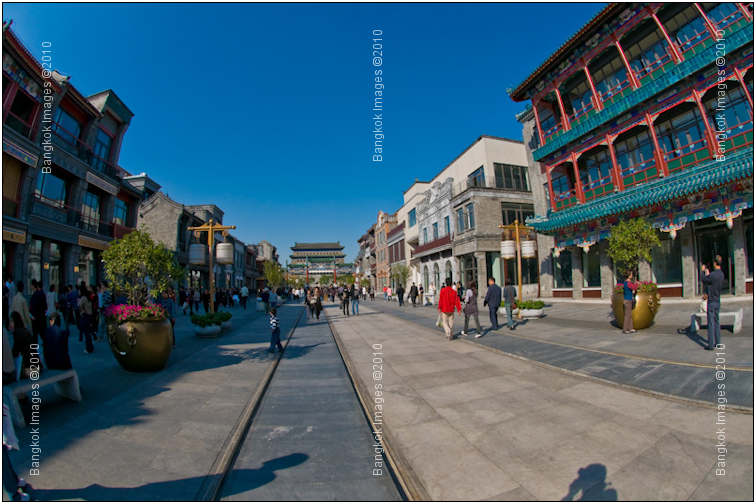
Most of the buildings had a bit of old Beijing Charm in them. One in particular housed a famous Beijing duck restaurant and really had a fancy exterior.
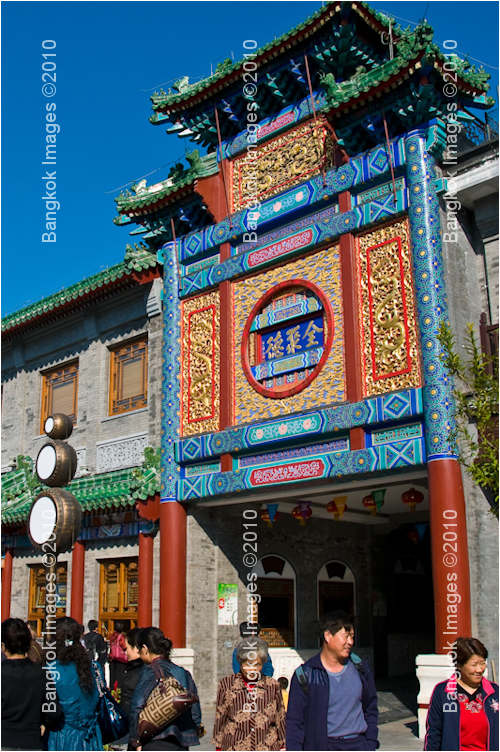
There are Trolley Tracks in the middle of the street and at peak tourist times a period recreated trolley runs the length of the street. Alas it was not running while we were there but the tracks added to the feel of the place.
Content on this page requires a newer version of Adobe Flash Player.
It was Anchored on the north side by a number of impressive traditional Chinese buildings. They looked very bright and colorful both day and night.
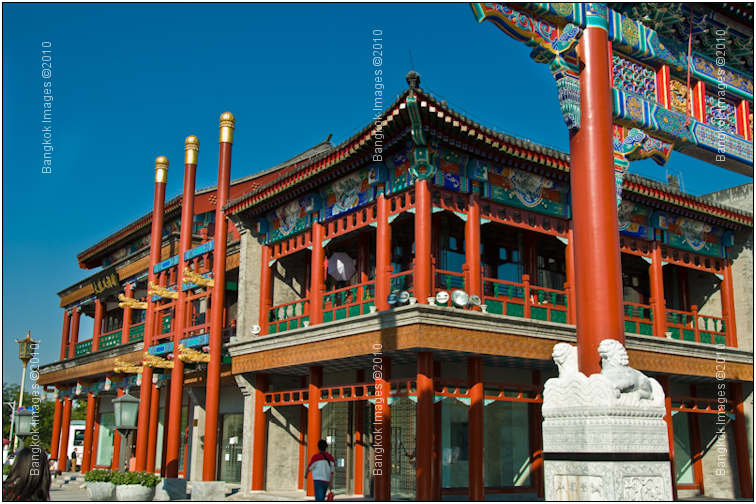
Looking north towards Tiananmen you see the entrance gate to Quinamen Street and the South Tower.

The South Tower is a large structure on the southern edge of Tiananmen Square and marks its entrance. In olden times it was a military tower of the Forbidden City Complex. It is one block from the South side of the Tiananmen complex.
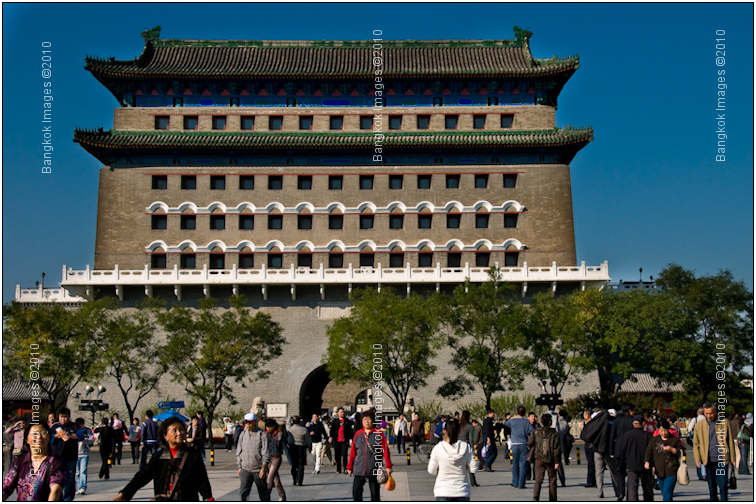
Looking back you see the South Tower from the rear
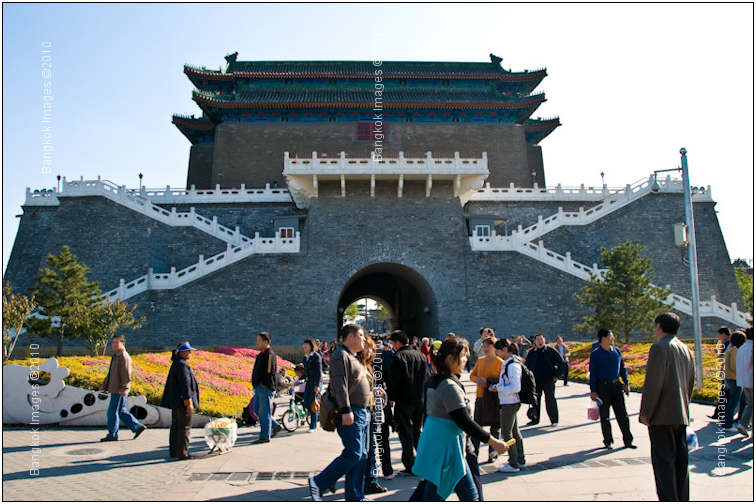
Access to Tiananmen Square is mostly via pedestrian underpasses which prevents you from having to cross busy roads. It was very convenient.
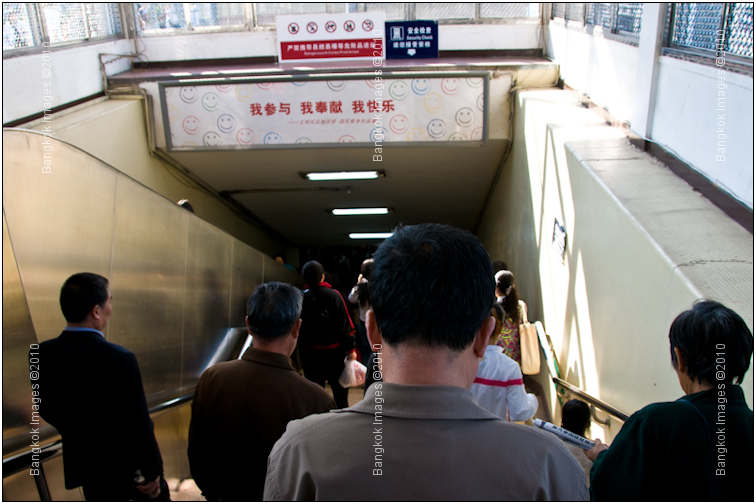
The South Gate (which is different than the South Tower) marks the entrance to Tiananmen square. It was red and colorful in the same way as the Forbidden City.
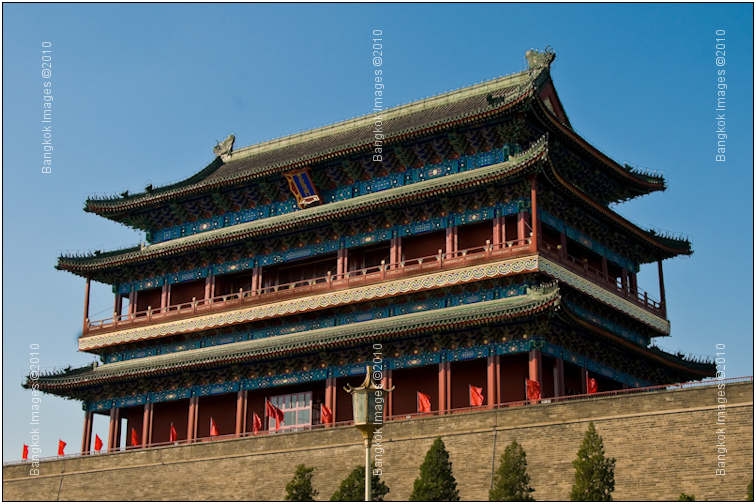
The Detail work on the gate was very impressive, it periodically gets repainted to keep it looking great.
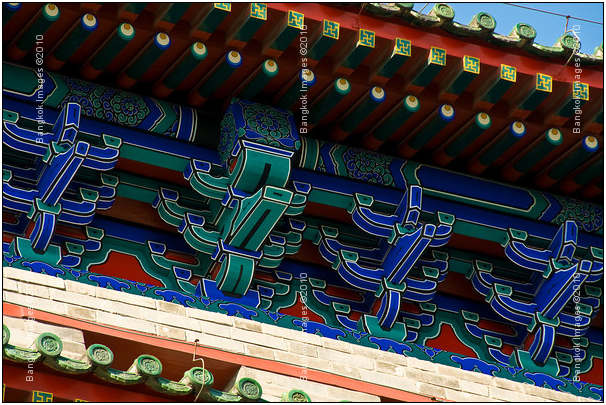
Going through the Gate puts you into Tiananmen Square which is billed as the largest urban square in the world. In some respects it is the heart of the city and has been the scene of many historic events in China’s long and tumultuous history.
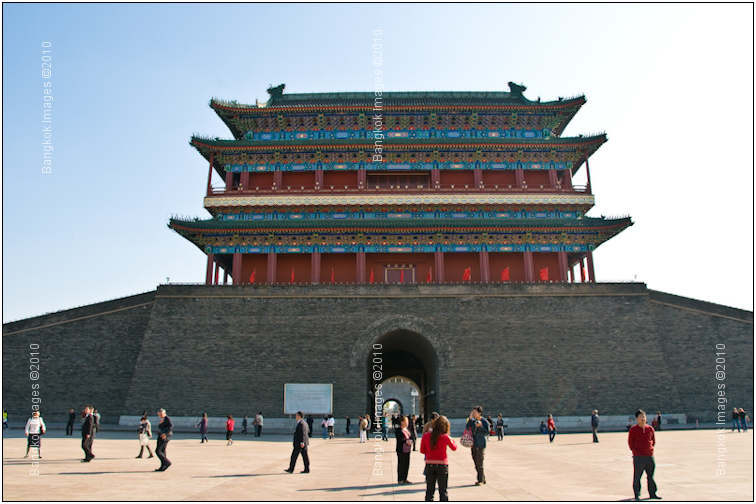
The scope of the square was quite impressive. It seemed to go on forever.
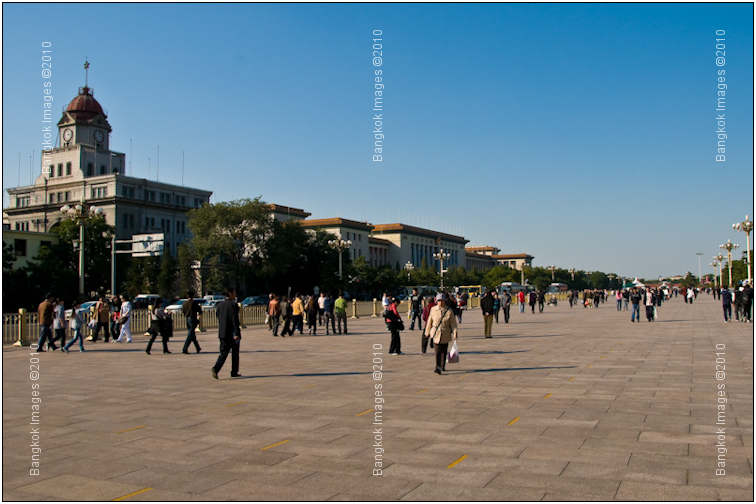
They had a number of guards standing watch throughout the square. Tiananmen is a flashpoint and gathering for political “unrest”. The guards are there to make sure everything remains approved and peaceful.
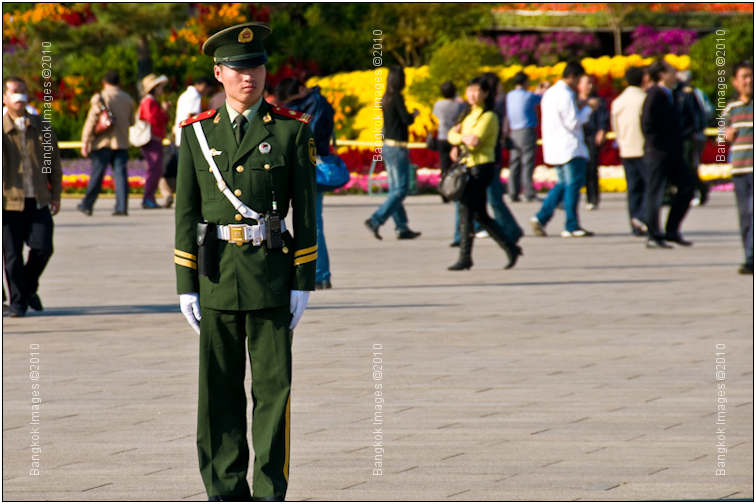
I had some mixed thoughts about the guards. I remembered the first time I had come to Tiananmen square I was very concerned about doing something “unapproved” by accident. On my first trip to China I had taken a picture of something I shouldn’t
have (but didn’t know) and found myself confronted by a PSB guard with his and on a pistol screaming and pointing at me in a language I didn’t understand. In the end my film was confiscated. Ever since then I have been wary of using
my camera around the boys in green.
During my first trip to Beijing years earlier I was very nervous about being in Tiananmen Square. Most of my knowledge of the place came from the Media coverage of the Protests back in 1989. I knew the place was in the national spotlight in a big way
and preparations were being made for the 50th anniversary of the founding of communist China. I figured security was going to super tight. To my surprise the guards seemed remarkably unconcerned with the presence of a snap happy westerner.
Even more to my surprise was when I was standing in the square at night watching people fly kites I had a guy come up and try and sell me a kite. Wasn’t China a communist country? Isn’t this place the hallowed ground of the communist government?
Yet here was a guy trying to sell me a kite.
Tiananmen is Flanked by several buildings. This one was a railway museum.
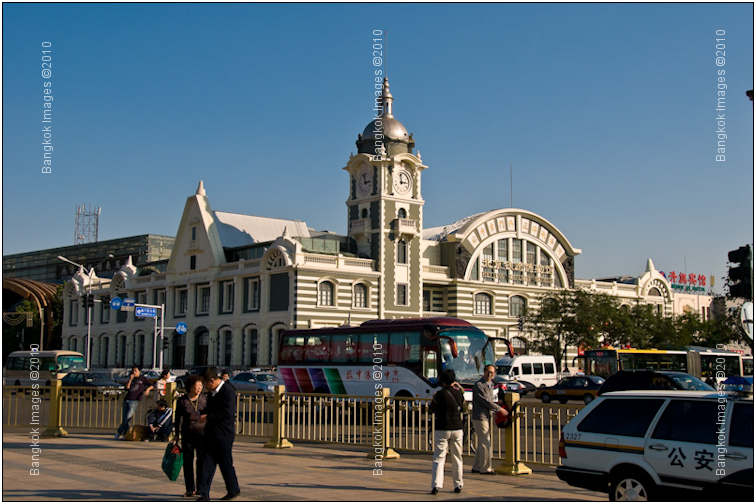
This is the Peoples hall, the Chinese equivalent of the Congress Building.
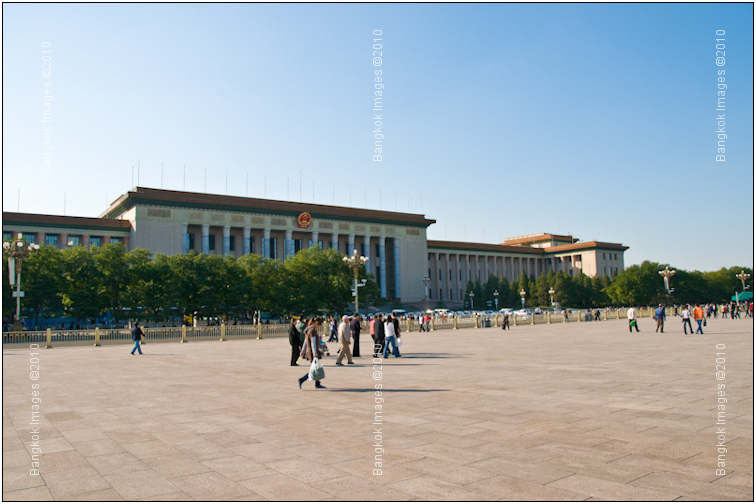
I stopped for a moment to take a 360VR before continuing my exploration of the square.
Content on this page requires a newer version of Adobe Flash Player.
Another section of the square is flanked by the National History museum. Previously it was divided into two sections, the pre-communist and post communist area. It was being renovated and combined into one Museum now.
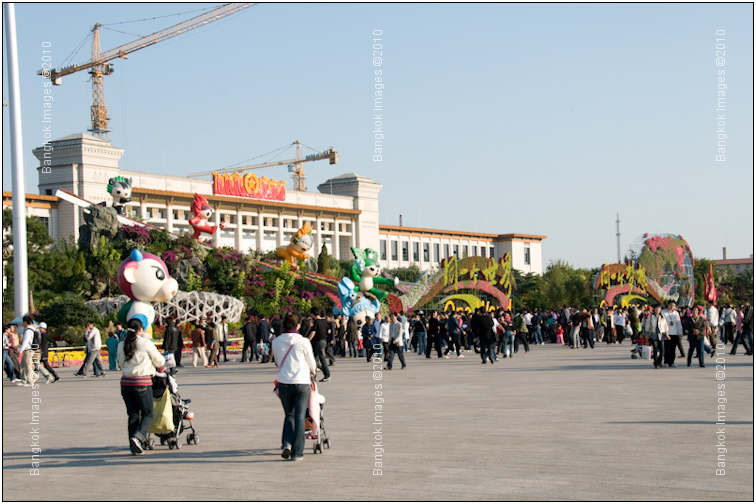
This picture also captures another big change from the past. If you look in the lower left hand portion you see two ladies with baby strollers. While this is unremarkable to most westerners it was a large change from my previous visits. In all my previous
travels though China I had seen a small handful of baby strollers. Now they were not as common as in the West but they were making their presence known as a testament to changing culture and prosperity.
Inside Tiananmen Square the most dominant structures are those dedicated to Mao. His mausoleum is the largest structure in the square.
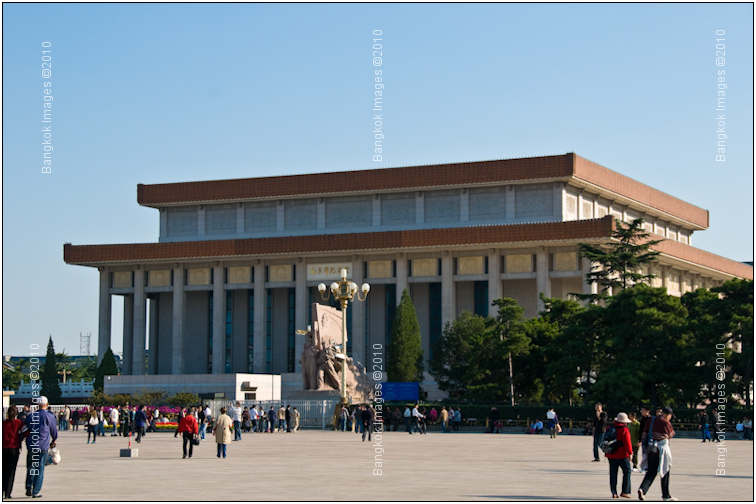
On each side is a statue of Mao leading the masses to a brighter future.
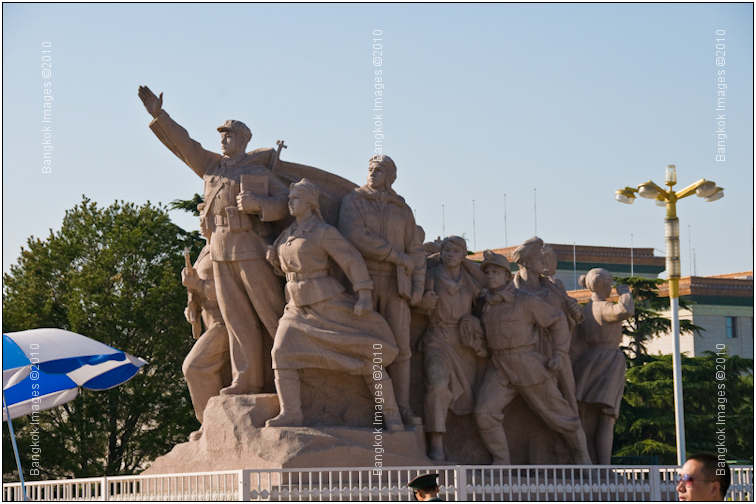
The Mao Tower was a pillar shaped monument to the greatness of Mao.
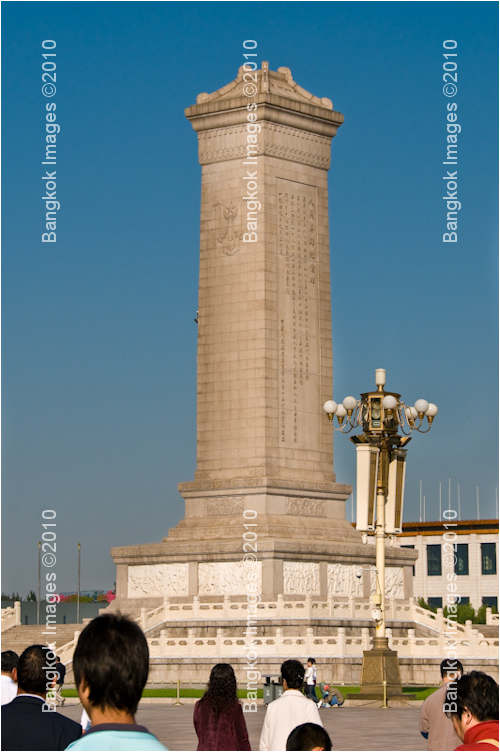
In addition to the historical attractions there were a number temporary displays scattered throughout the square.
There was a giant Chinese lantern. A super sized version of a decoration commonly found hanging in buildings.
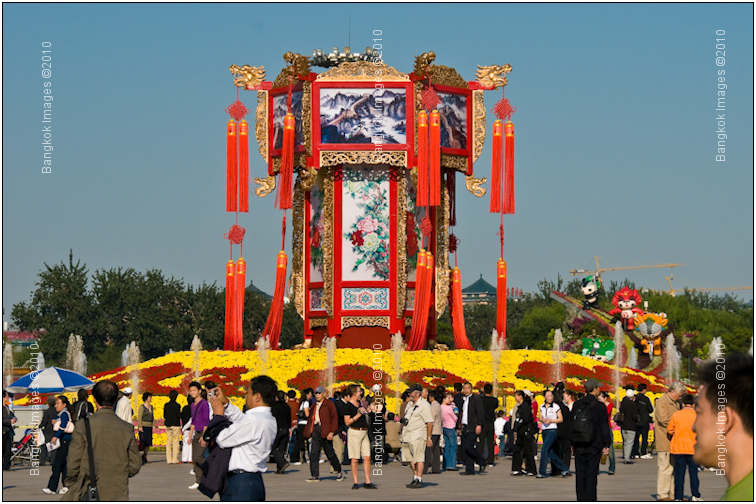
There was a display of the Olympic Mascots. These creatures were featured prominently in Olympic advertising and many children’s shows.
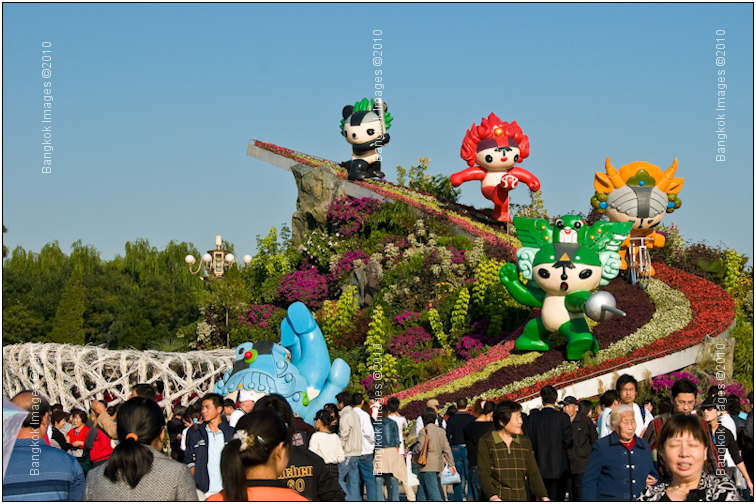
The Bridge of flowers was a very impressive display in both its scale and color.
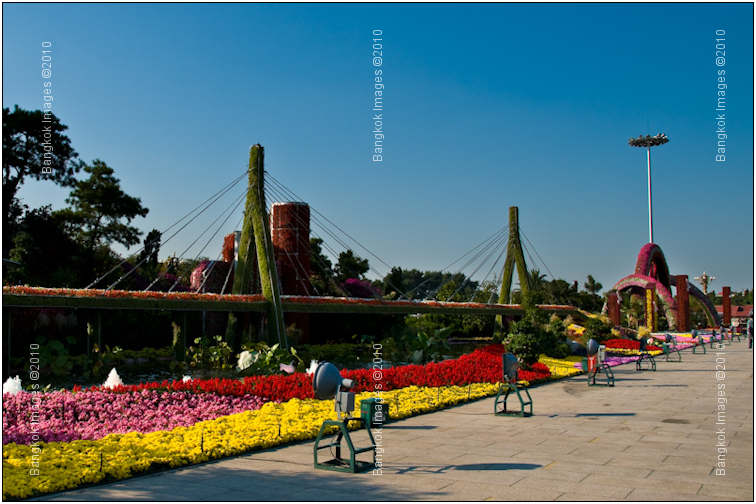
There was also a Flowering arch of similar design.
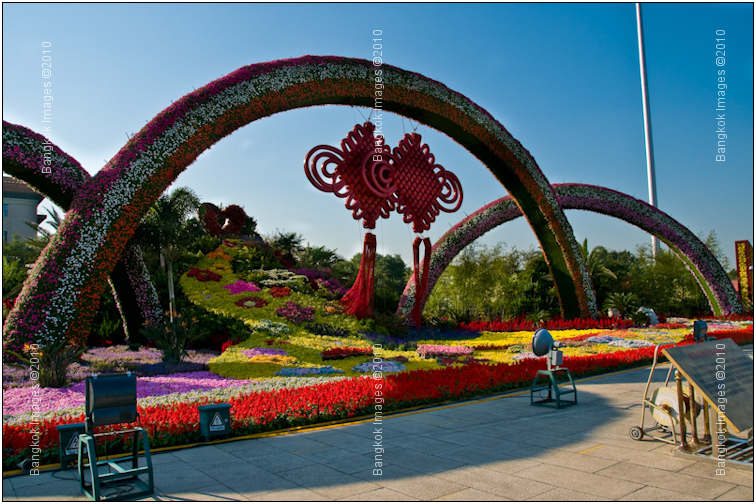
I paused to take another 360VR of the square to try and capture not only the square but some of the goings on of the people in it.
Content on this page requires a newer version of Adobe Flash Player.
After I got through taking those shots an interesting thing happened. And old guy came up to me and got my attention. I figured he was going to try and sell me something but instead he handed me his digital camera and told me it wasn’t working
and asked if I could fix it. It was a seriously antiquated point and shoot but I took a look at it. His memory was full and after some communication issues (my Chinese is pretty minimal) I deleted some pictures he didn’t seem to want to
keep and sent him on his way. About 15 seconds after that ANOTHER person came up to me with another camera. In their case they were out of battery power, nothing I could do for that. While I was examining their camera I noticed a third old person
hovering around and realized I might be here for some time if I kept fixing things. So after I sent the second lady off I scooted away in another direction.
Further North on the Square Tiananmen Gate came into view. This Marks the entrance the entrance to the Forbidden City and is home to the famous painting of Mao who watches over the square. The painting is changed out on a periodic basis to make sure it
is always looking good.
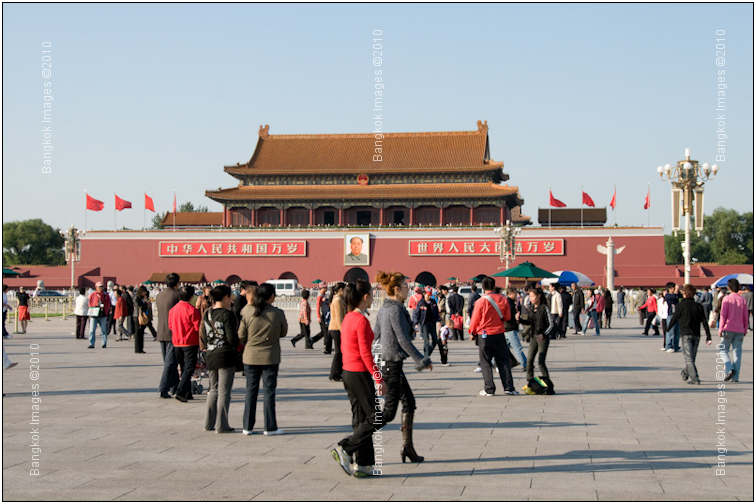
We made our way out of the square, under the street and up to the entrance to the Forbidden City.
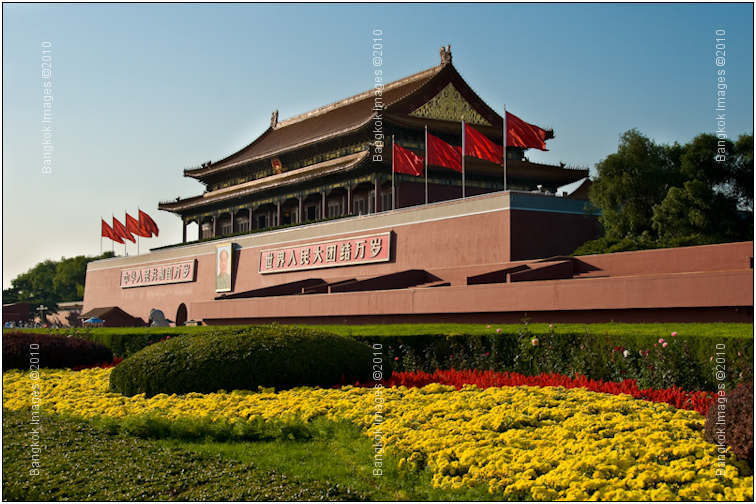
We showed up just in time to see a squad of square guards marching out for duty.
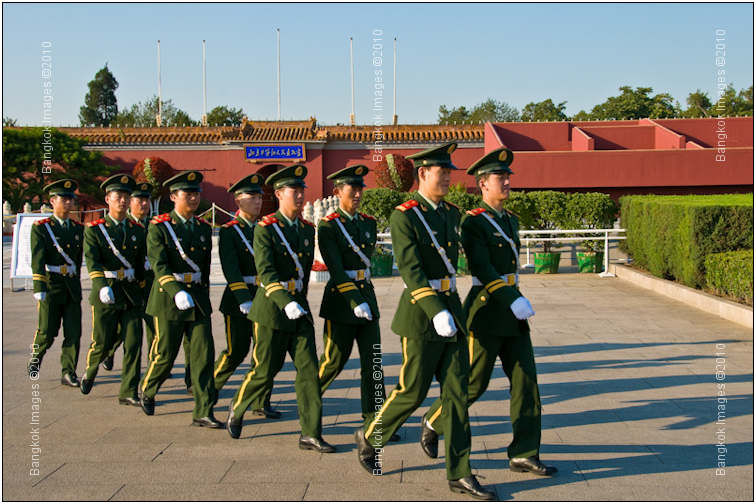
In addition to keeping an eye on they place they serve as a ceremonial tourist attraction. They have a barracks inside the outer courtyard in the Forbidden city where they form up and deploy from. They march out from that on a proscribed route deploying
to their various posts.
We went over one of the bridges and through one of the massive gates into the outer courtyard of the Forbidden city.
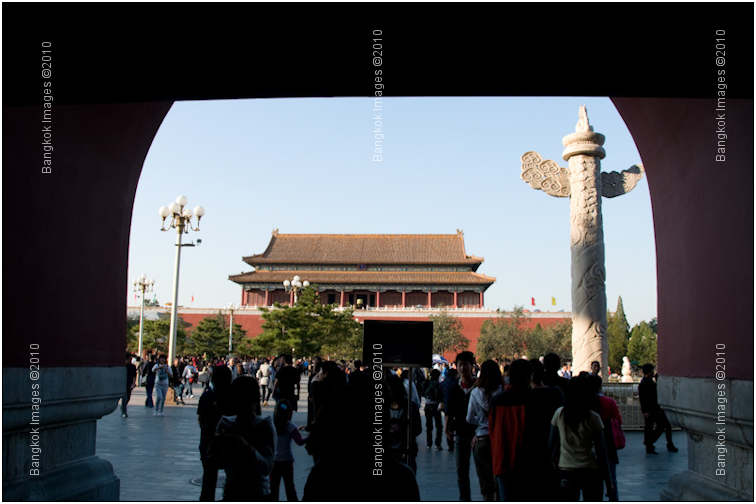
The outer courtyard is part of the Forbidden City complex but is accessible to the public without a fee.
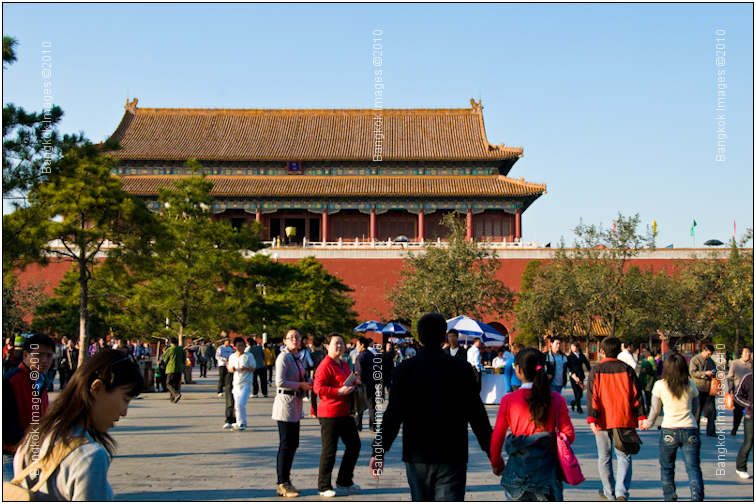
We wandered though the courtyard for a while enjoying the sights and sounds.
Content on this page requires a newer version of Adobe Flash Player.
One of the Buildings on the inner wall was open for visiting so we decided to go check it out.
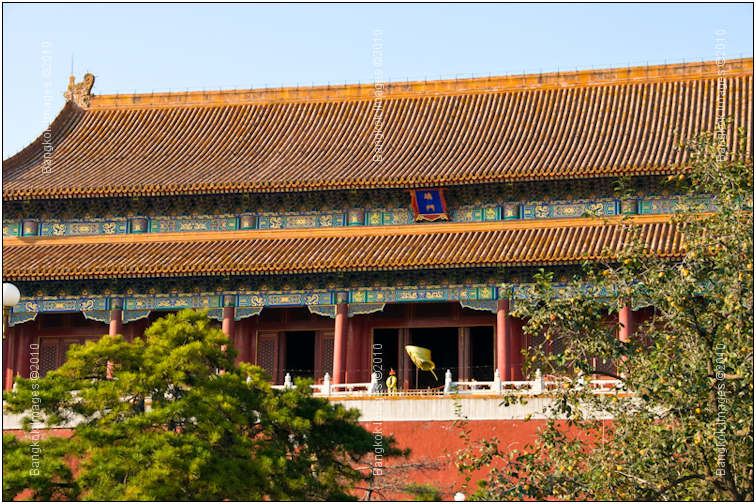
Admission was free but you had to have our luggage checked. They seemed to be focused on making sure people didn’t bring drinks up for whatever reason. Form up top you got an excellent view of the courtyard below.
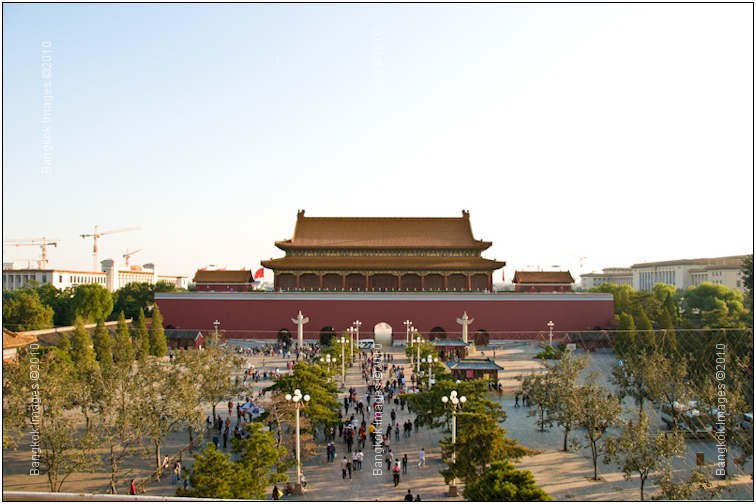
As well as the roofline of some of the surrounding buildings in the Forbidden City.
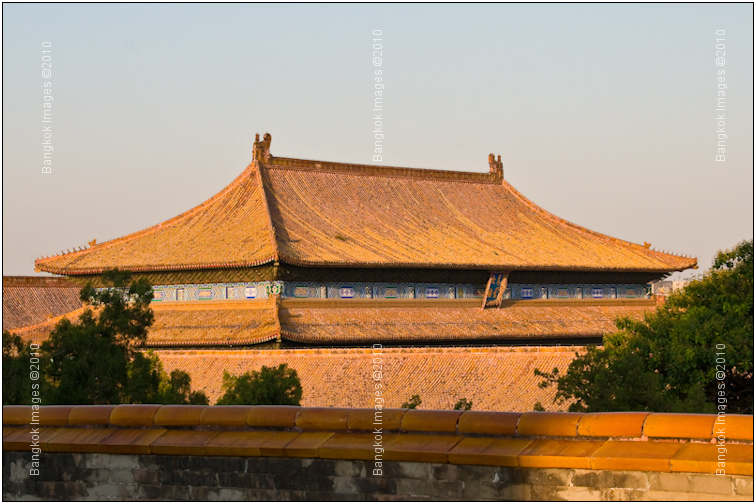
After going back down we stopped at one of the Souvenirer Stalls. My wife went to go buy some stuff while I hung back. We had learned quite some time ago that if I go shopping with her price doubles or triples or more just because I’m there.
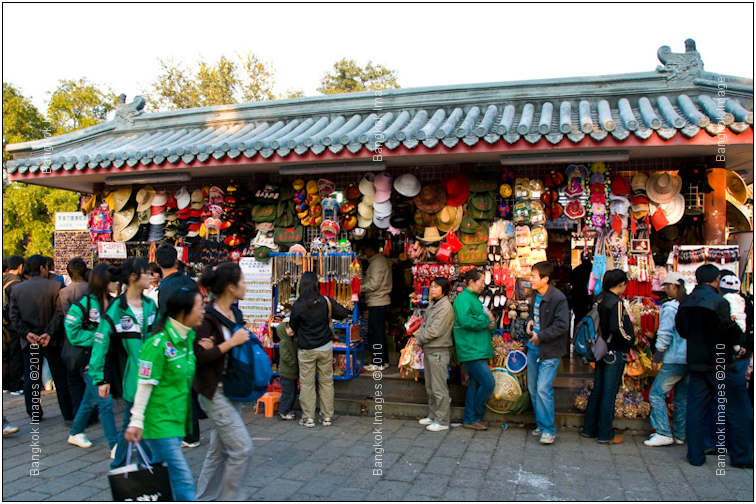
After collecting the requested souvenirs we planned on going back to the square. We (and a couple of thousand other people) found our plans delayed somewhat by the lowering of the flags ceremony. When they lower the flags at sunset the shut the gates
and cut off access to and from the are in front of Tiananmen gate.
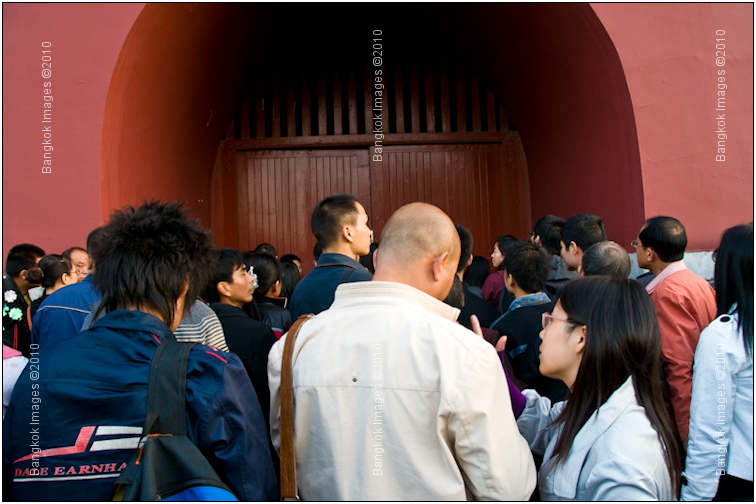
Eventually we got out of the courtyard and looked back at the flagless gate in the setting sun before heading out to do some shopping.
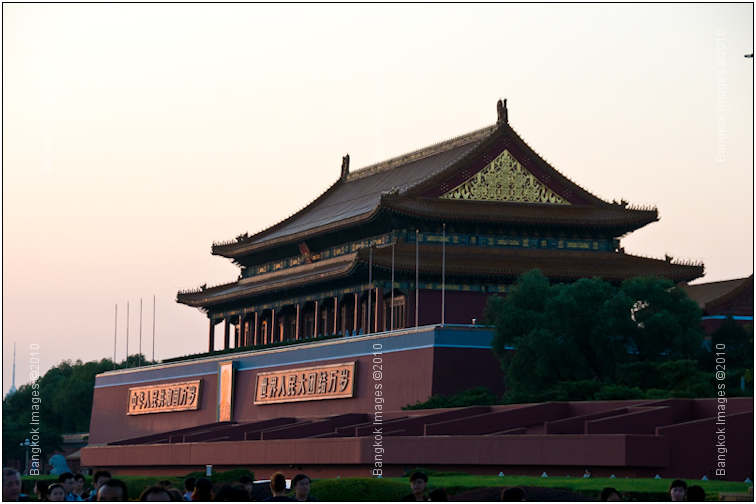
It had been a wonderful afternoon.



